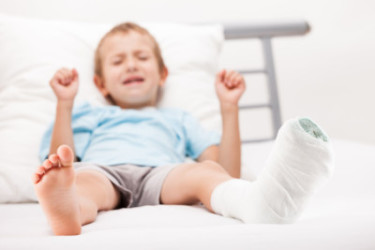 As a parent, you want to prevent your child from getting injured and nurse them back to health quickly once they’re in pain, but you don’t always want to rely on medications and painkillers to do the job. Children may have unidentified allergies to certain medications, and painkillers may affect your child more than you had hoped. Today, we’re going to share some tips for treating child foot injuries without relying on pain pills.
As a parent, you want to prevent your child from getting injured and nurse them back to health quickly once they’re in pain, but you don’t always want to rely on medications and painkillers to do the job. Children may have unidentified allergies to certain medications, and painkillers may affect your child more than you had hoped. Today, we’re going to share some tips for treating child foot injuries without relying on pain pills.
Treating Foot Pain
Here are five ways to naturally treat your child’s foot injury.
1. Rest – We know how difficult it can be to keep young kids off their feet, but rest is one of the best treatment options for a foot injury. Whether it’s a stress fracture from ballet or an ankle sprain from a soccer game, getting them to stay off their feet can really help their injury heal. Missing one or two games while they recover can greatly reduce the likelihood of re-injury when they return.
2. Ice – Icing an injury is another way to prevent pain. Cold therapy will help relieve pain and prevent swelling by reducing bloodflow to the injured area. The reduction in bloodflow helps prevent inflammation from setting in. Wrap an ice bag in a dish towel or grab a bag of frozen peas from the freezer and apply it to the injured area for 15 minutes twice a day.
3. Elevate the Injury – Speaking of reducing bloodflow to the area, elevating an injury is another great treatment technique after a foot or ankle injury. Again, keeping the injury above your heart will limit circulation in the area and will help prevent painful inflammation from occurring. If your child is laying on the couch or resting in bed, prop their foot up on a couple of pillows.
4. Heat – Heat therapy is another treatment technique to consider based on the type of injury your child suffers. Cold therapy is great for sprains or acute blows, while heat is great for muscle soreness or stiff joints. Heat does the opposite of cold therapy in that it helps increase bloodflow to the area. Sore muscles may not be getting enough oxygen from the bloodstream, but heat can help change that.
5. Wound Watching – Assuming you’re dealing with an external injury like a cut, keeping an eye on the injury over the next few days is another way to ensure it heals properly. You’ll want to clean the wound with antiseptic wipes every day, and change your bandage and dressing at least once a day, especially if the wrapping gets wet. Look for signs of an infection, like redness, swelling or discharge. If it gets worse, call a doctor, otherwise just continue to monitor the wound until it has healed.